Tracery
In architecture, tracery is an architectural device by which windows (or screens, panels, and vaults) are divided into sections of various proportions by stone bars or ribs of moulding.[1] Most commonly, it refers to the stonework elements that support the glass in a window. The term probably derives from the tracing floors on which the complex patterns of windows were laid out in late Gothic architecture. Tracery could also be found on the interior of buildings and the exterior.[2]
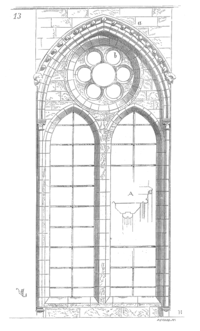
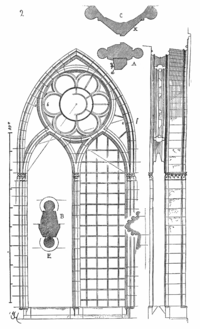
There are two main types: plate tracery and the later bar tracery.[3] The evolving style from Romanesque to Gothic architecture and changing features, like the thinning of lateral walls and enlarging of windows lead to the innovation of tracery. The earliest form of tracery, called plate tracery, began as openings that were pierced from a stone slab. Bar tracery was then implemented, having derived from the plate tracery. However, instead of a slab, the windows were defined by moulded stone mullions, which were lighter and allowed for more openings and intricate designs.[4]
Pointed arch windows of Gothic buildings were initially (late 12th–late 13th centuries) lancet windows, a solution typical of the Early Gothic or First Pointed style and of the Early English Gothic.[1][5] Plate tracery was the first type of tracery to be developed, emerging in the later phase of Early Gothic or First Pointed.[1] Second Pointed is distinguished from First by the appearance of bar-tracery, allowing the construction of much larger window openings, and the development of Curvilinear, Flowing, and Reticulated tracery, ultimately contributing to the Flamboyant style.[5] Late Gothic in most of Europe saw tracery patterns resembling lace develop, while in England Perpendicular Gothic or Third Pointed preferred plainer vertical mullions and transoms.[5] Tracery is practical as well as decorative, because the increasingly large windows of Gothic buildings needed maximum support against the wind.[2]
Plate tracery
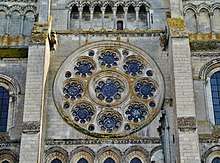
Plate tracery, in which lights were pierced in a thin wall of ashlar, allowed a window arch to have more than one light - typically two side-by-side and separated by flat stone spandrels.[1] The spandrels were then sculpted into figures like a roundel or a quatrefoil.[1] Plate tracery reached the height of its sophistication with the 12th century windows of Chartres Cathedral and in the "Dean's Eye" rose window at Lincoln Cathedral.[2]
The earliest form of window tracery, typical of Gothic architecture prior to the early 13th century, is known as plate tracery because the individual lights (the glazed openings in the window) have the appearance of being cut out of a flat plate of masonry. Romanesque church windows were normally quite small, somewhat taller than wide and with a simple round-headed ('segmental') arch at the top. From around the 1140s, the pointed arch Gothic window (employed by Abbot Suger for the redesign of the choir at St Denis) started to take over.
.jpg)
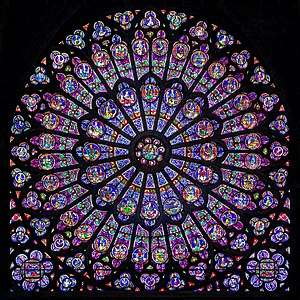
As the buttressing systems of early Gothic architecture reduced the structural need for broad expanses of thick walls, window openings grew progressively larger and instead of having just one very large window per bay division (which would create problems with supporting the glass), the typical early-Gothic 'twin lancet plus oculus' form of plate tracery developed. This consists of two (sometimes three) tall thin lights topped with pointed arches, with a round or trefoil opening placed above them, often contained within a blind arch which gives the whole assemblage a pointed lancet shape (see the example from Soissons Cathedral). With this type of design, the spandrels (i.e. the spaces between the tops of the lancet windows and the oculus) are just blank wall. The practicalities of building window tracery in this way severely limited the complexity of designs that could be produced and although plate tracery designs evolved over the course of the 12th and early 13th centuries, in practice, the only real variation was in the number and size of lancets and in the trefoils, quatrefoils and oculi used to fill the spaces above them.
The rose windows of early- and high-Gothic cathedrals, such as the example in the north transept of Laon Cathedral (1170s) or the west facade at Chartres (c. 1210), also employed plate tracery. This greatly limited the overall amount of light admitted to the interior by these windows, as well as restricting the complexity of patterns that could be created.
Bar tracery

At the beginning of the 13th century, plate tracery was superseded by bar-tracery.[1] Bar-tracery divides the large lights from one another with moulded mullions.[1] Bar-tracery, an important decorative element of Gothic styles, appeared first at Reims and was employed in England around 1240.[1] After 1220, master builders in England had begun to treat the window openings as a series of openings divided by thin stone bars, while before 1230 the apse chapels of Reims Cathedral were decorated with bar-tracery with cusped circles (with bars radiating from the centre).[2] Bar-tracery became common after c.1240, with increasing complexity and decreasing weight.[2] The lines of the mullions continued beyond the tops of the window lights and subdivided the open spandrels above the lights into a variety of decorative shapes.[1] Rayonnant style (c.1230–c.1350) was enabled by the development of bar-tracery in Continental Europe and is named for the radiation of lights around a central point in circular rose windows.[1] Rayonnant also deployed mouldings of two different types in tracery, where earlier styles had used moulding of a single size, with different sizes of mullions.[2] The rose windows of Notre-Dame de Paris (c.1270) are typical.[2]
The earliest bar tracery designs were made for the aisle windows at Reims Cathedral around 1215. The Reims windows still used the same 'two lancets plus oculus' pattern (as in the Soissons example above), but now the glass panels were held between narrow stone mullions made up of carefully shaped lengths of masonry (fitted together with mortar and metal pins) quite distinct from the wall surrounding them. These mullions were much more slender than the corresponding elements in plate tracery windows and crucially, the previously solid wall areas such as the spandrels could also now be glazed, greatly increasing the amount of light admitted.
The cross-section of each mullion or tracery bar was important both for the structural integrity of the window and for the visual effect. As can be seen in Viollet-le-Duc's diagram (right) there was normally a roll-moulding on both the inside and outside of the windows, which made the mullions appear even more slender than they actually were. The shoulder marked 'B' on the diagram is the glazing slot, into which the metal frame (armature) of the window glass is mounted. Unlike with plate tracery, where each stone had to be individually shaped, the elements of bar tracery could be mass-produced to standard templates in the mason's yard – work that could continue even when it was too cold for lime mortar to set. The technical aspects of the windows at Reims clearly fascinated Villard de Honnecourt, who visited the construction site, probably in the 1220s, and made a detailed sketch of the various templates, using a key to show how they fitted into the different parts of the window (the templates are in the lower half of folio 32 recto; the symbols besides the templates match similar ones on the detailed drawing of the Reims elevations on the facing page, folio 31 verso).


Geometrical tracery
The early phase of Middle Pointed style (late 13th century) is characterized by Geometrical tracery - simple bar-tracery forming patterns of foiled arches and circles interspersed with triangular lights.[1] The mullions of Geometrical style typically had capitals with curved bars emerging from them. Intersecting bar-tracery (c.1300) deployed mullions without capitals which branched off equidistant to the window-head.[1] The window-heads themselves were formed of equal curves forming a pointed arch and the tracery-bars were curved by drawing curves with differing radii from the same centres as the window-heads.[1] The mullions were in consequence branched into Y-shaped designs further ornamented with cusps. The intersecting branches produced an array of lozenge-shaped lights in between numerous lancet arched lights. Y-tracery was often employed in two-light windows c.1300.[1]
Geometrical tracery is identified by the circular openings at the head of the arch of the window. A common composition is three lights beneath two circles and a third at the point of the arch,[6] such an example can be seen along the aisle at the Lincoln Cathedral in England. Also at the Lincoln Cathedral, the east window is an expanded version of this idea with two interior arches, a total of eight lower lights, four small circular lights topped with two larger circles to fill out the interior arches, and finally above all one large circular shape filled with seven smaller circular lights. Geometrical tracery, in its early stages, had a rule of equilateral law, where the tracery design follows the shape of the arch in an equilateral manner. Additional decorative elements can be implemented, such as foliation or the "spherical triangle". The use of spherical triangles is a later adaption and likely reflects religious significance.[7]
Curvilinear (flowing) tracery
Second Pointed (14th century) saw Intersecting tracery elaborated with ogees, creating a complex reticular (net-like) design known as Reticulated tracery.[1] Second Pointed architecture deployed tracery in highly decorated fashion known as Curvilinear and Flowing (Undulating).[1] These types of bar-tracery were developed further throughout Europe in the 15th century into the Flamboyant style, named for the characteristic flame-shaped spaces between the tracery-bars.[1] These shapes are known as daggers, fish-bladders, or mouchettes.[1]
Starting in the late thirteenth century and at the beginning of the fourteenth century tracery took on more fluid characteristics. A common shape that was used in curvilinear tracery was that of the ogee, which was too weak for structural application and was instead used as a decorative element. The use of the ogee in curvilinear tracery can be seen in the west window of St Mary's parish church in Cottingham, East Riding of Yorkshire.[8]
A secondary style, considered related to curvilinear tracery, is called reticulated tracery. Reticulated tracery fills the head of the arch with repeated forms creating the appearance of a net-like pattern.[9]
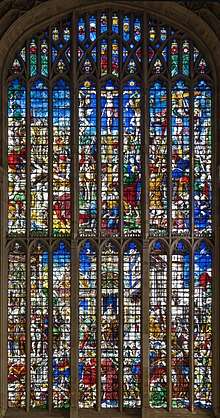
Perpendicular
Third Pointed or Perpendicular Gothic developed in England from the later 14th century and is typified by Rectilinear tracery (panel-tracery).[1] The mullions are often joined together by transoms and continue up their straight vertical lines to the top of the window's main arch, some branching off into lesser arches, and creating a series of panel-like lights.[1] Perpendicular strove for verticality and dispensed with the Curvilinear style's sinuous lines in favour of unbroken straight mullions from top to bottom, transected by horizontal transoms and bars.[2] Four-centred arches were used in the 15th and 16th centuries to create windows of increasing size with flatter window-heads, often filling the entire wall of the bay between each buttress.[1] The windows were themselves divided into panels of lights topped by pointed arches struck from four centres.[1] The transoms were often topped by miniature crenallations.[1] The windows at King’s College Chapel, Cambridge (1446–1515) represent the heights of Perpendicular tracery.[2]
Blind and open tracery
As bar tracery opened the way for more complex patterns, masons started applying those same patterns to other surfaces as well as the actual window openings. When used on an otherwise solid walls, such motifs are known as blind tracery, a decorative effect first applied on the west facade of the church of St Nicaise at Reims (1230's). Conversely, tracery was also constructed as openwork screens, which could either match the window tracery behind them (e.g. the Basilica of Saint Urbain, Troyes) or create a visual counterpoint to it, as on the exterior of the west facade of Strasbourg Cathedral. Open tracery in particular was a key feature of the later phases of Rayonnant and Flamboyant Gothic.
Tracery patterns
Most 19th-century histories of Gothic architectural style used a series of typological categories based on the evolution of the dominant patterns of window tracery. In terms of the overall development of Gothic architecture, the crucial development was not so much the use of any particular tracery patterns but the transition from plate- to bar-tracery, which was what made the Rayonnant and subsequent styles possible. To construct traceries proportionately it is important to use the basis of geometry to help create correct angles for the design.[10][11][12]
Rounded quatrefoils
In Gothic tracery, rounded quatrefoils have been used quite a bit in modern industrial ornament which is used to embellish different parts of a building or certain objects. This is formed with the use of squares as the base and then constructing circles tangent to each side of the square in the center of the side as well as a tangent to each of the circle's sides. This type of construction is used generously in Gothic buildings.[11] For instance, rounded quatrefoils were used in tiled pavements like the ones in the Gloucester Cathedral or the in Great Malvern, Worcestershire, England. It was also common in the work of the Chinese and Japanese.[11]
Rounded multifoils
Rounded multifoils are found in different parts of gothic buildings such as circular windows and pointed windows that have circular lights in it. These designs can have rings ranging from seven to eleven small circles. They are often seen in England but have become quite popular in France for French Gothic architecture.[11] This design has been used since about around medieval time in tiles that Gothic building use. The tile pavement used in Yorkshire, England for Jervaulx Abbey had rings of tangents circles of six and twelve inside of another given circle.[11]

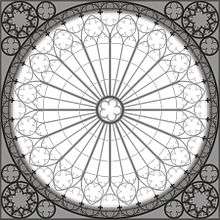
Tracing floors and épures
As the complexity of tracery increased, so did the need for masons to draw out their designs in advance, either as a way of experimenting with patterns or as a way of communicating their designs to other craftsmen or to their patrons. Because of the cost and size limitations of parchment sheets, such designs would normally be drawn by incising onto a whitewashed board or a conveniently placed section of flat wall. In the latter case, the wall would be prepared with a thin layer of plaster, which would show the design more clearly.
A number of churches and cathedrals still show the faint remains of these tracings (or épures as they are known in France), from where the mason's compass points scratched through the plaster and into the masonry below. (Examples include some experimental 14th century window tracery patterns at the eastern end of the south wall inside the Galillee porch of Ely Cathedral, or the extensive series of tracings on the flat aisle roofs of Clermont-Ferrand Cathedral.) A number of major building sites (including Westminster Abbey, Wells Cathedral and York Minster) originally had dedicated tracery chambers, where the architects could prepare their designs in relative comfort. The availability of a large flat floor surface meant that designs could be drawn life-size and the individual elements of bar tracery laid out on the plan to test their goodness of fit, before hoisting them up the scaffolding for installation in the actual window openings. This also meant that masons could carry on working through the winter season, when building work would normally grind to a halt.
The tracing floors themselves were covered with plaster-of-Paris, which could be relaid and smoothed down after each set of designs were finished with. The 14th-century tracing house at York (also known as the Mason's Loft) survives to this day on the upper storey of the corridor leading to the Chapter House, the complex web of lines and curves scratched into the floor serving as witnesses to the countless different designs that were worked out in there. The high-quality carpentry and the inclusion of a garderobe and fireplace in the York tracing house also give an indication of the rising status of the architect around the 14th century.
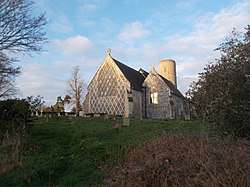
See also
- Church window
- Stained glass
- Branchwork using tree branch forms, late northern Gothic
- Foil (architecture)
- Rosette (design)
- Three hares
- Sources
| Wikimedia Commons has media related to Tracery. |
- Bony, Jean (1983). French Gothic Architecture of the 12th and 13th Centuries. University of California Press.
- Wilson, Christopher (1990). The Gothic Cathedral. London. Eespecially 120ff.
- Frankl, Paul; Crossley, Paul (2000). Gothic Architecture. Yale University Press.
References
- Curl, James Stevens; Wilson, Susan, eds. (2015), "tracery", A Dictionary of Architecture and Landscape Architecture (3rd ed.), Oxford University Press, doi:10.1093/acref/9780199674985.001.0001/acref-9780199674985-e-4762, ISBN 978-0-19-967498-5, retrieved 2020-05-26
- "tracery | Definition & Facts". Encyclopedia Britannica. Retrieved 2020-05-26.
- Honour, H. and J. Fleming, (2009) A World History of Art. 7th edn. London: Laurence King Publishing, p. 948. ISBN 9781856695848
- Hamlin, Alfred (1906). A text-book of the history of architecture (7 ed ed.). New York, Longmans. pp. 188.
- Curl, James Stevens; Wilson, Susan, eds. (2015), "Gothic", A Dictionary of Architecture and Landscape Architecture (3rd ed.), Oxford University Press, doi:10.1093/acref/9780199674985.001.0001/acref-9780199674985-e-2072, ISBN 978-0-19-967498-5, retrieved 2020-04-09
- Bradley, Simon (2016). Churches: An Architectural Guide. New Haven : Yale University Press.
- Freeman, Edward Augustus (1851). Books on Google Play An Essay on the Origin and Development of Window Tracery in England; with Nearly Four Hundred Illustrations. Oxford & London, John Henry Parker. pp. 13, 14, 24, 28, 29.
- Bradley, Simon (2016). Churches: An Architectural Guide. New Haven : Yale University Press.
- Ching, Francis D.K. (2012). A visual dictionary of architecture (English : 2nd ed.). Hoboken, N.J. : Wiley. p. 275.
- Phillips, E. C. (August 1926). "Some Applications of Mathematics to Architecture: Gothic Tracery Curves". The American Mathematical Monthly. 33 (7): 361–368. doi:10.2307/2298643. ISSN 0002-9890. JSTOR 2298643.
- Sykes, Mabel (1994). A sourcebook of problems for geometry : based upon industrial design and architectural ornament. Palo Alto, CA: Dale Seymour Publications. pp. 161–177. OCLC 31334043.
- "The Geometry of Gothic Architecture" (PDF). www.ministryofstone.com. Retrieved 2018-12-06.